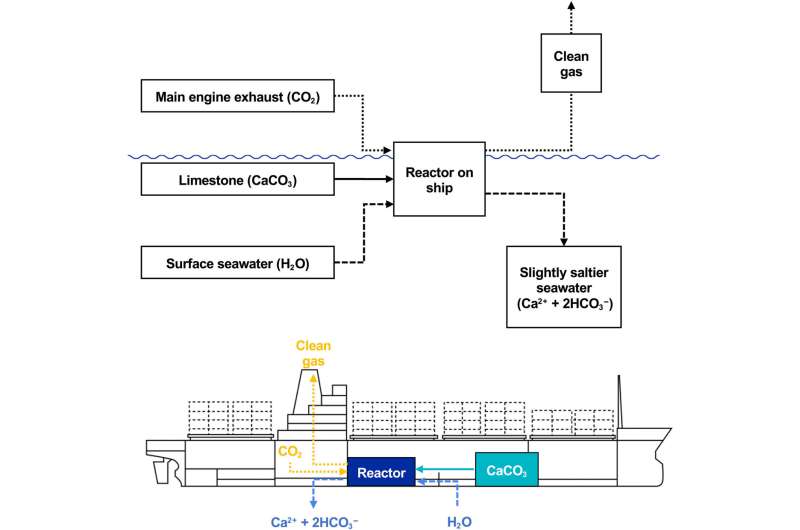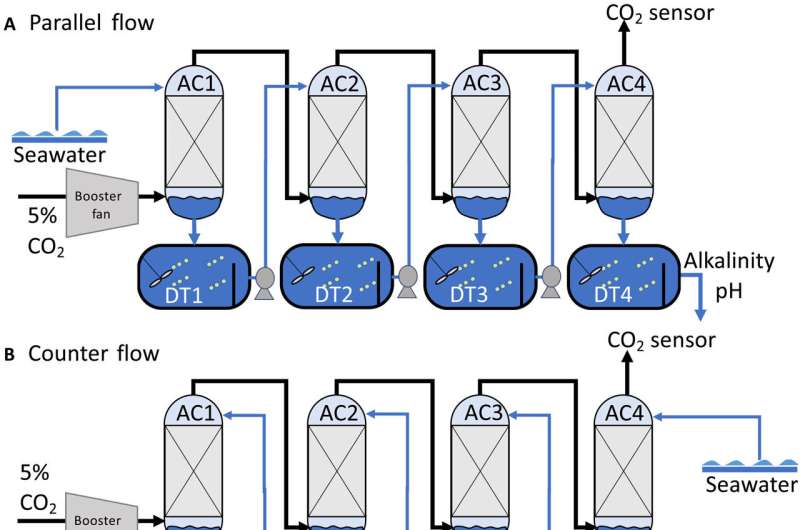
Researchers from USC and Caltech, working alongside the startup Calcarea, have created an innovative system for ships that can potentially cut carbon dioxide emissions from shipping by up to 50% by turning it into a safe solution for the ocean.
This exciting development, detailed in Science Advances, aims to tackle emissions from one of the most challenging sectors to decarbonize.
“What makes this so appealing is its simplicity,” mentioned William Berelson, a faculty member at USC’s Dornsife College and a co-author of the study. “We’re enhancing a natural process that already helps to balance CO2 in the ocean—this just happens onboard ships, effectively reducing emissions on a large scale.”
The method simulates a natural ocean reaction. As ships sail through seawater, the carbon dioxide from their exhaust gets absorbed into water taken onboard, slightly increasing its acidity. This water is then passed through limestone, where chemical reactions take place that transform the acid into bicarbonate, a harmless substance already found in seawater. The finished water, now free of CO2, is then released back into the ocean.
“What excites me is that this stemmed from basic scientific inquiries: How does the ocean manage CO2 levels?” Berelson said. “From that understanding, we realized we might have a viable solution for climate change.”

From Lab to Ocean
Shipping contributes to nearly 3% of global emissions. Traditional solutions such as low-carbon fuels and electrification often prove costly or unsuitable for long-haul journeys.
“Our method complements existing strategies without requiring major redesigns of ships,” stated Jess Adkins, CEO of Calcarea and a professor at Caltech.
In laboratory settings, researchers tested essential aspects of the process using measured amounts of seawater, limestone, and CO2. Their experiments showed strong agreement with theoretical predictions, giving them confidence to expand their models for real vessels.
“We aimed to establish that we understood the chemistry involved and could predict CO2 reduction accurately,” Berelson explained. “This helped us envision how it might be implemented on actual ships.”
The study also integrated advanced ocean modeling to analyze the impact of releasing bicarbonate-rich water back into the ocean. Simulations were run based on a hypothetical ship traveling between China and Los Angeles over ten years, releasing treated water along the route. Results indicated minimal changes to ocean pH and chemistry, affirming the technology’s safety for the environment.
Researchers believe that if this technique sees widespread adoption, it could decrease carbon dioxide emissions from shipping by 50%.
“This scale is essential if we are serious about reducing global emissions,” Berelson said. “Although it won’t happen immediately, it showcases what is achievable.”
Commercializing the Innovation
While academic research progresses, Calcarea is actively pursuing ways to take this technology into the marketplace. They are in early talks with shipping companies and contemplating pilot programs to test the technology on operational vessels.
Calcarea has already partnered with Lomar Shipping’s innovation hub, Lomar Labs, to help bring their shipboard carbon capture system into practical use.
“Our design inherently supports scalability,” said Adkins. “We’re developing a system that can fit into current vessels and be adopted across fleets. By collaborating with industry partners, we are speeding up the journey from the lab to the ocean.”
Berelson, also a co-founder and advisor for Calcarea, continues to investigate the science behind this approach, focusing on reaction rates and long-term effects on ocean chemistry.
More information:
Sijia Dong et al, Potential of CO2 sequestration through accelerated weathering of limestone on ships, Science Advances (2025). DOI: 10.1126/sciadv.adr7250
If you would like to see similar Tech posts like this, click here & share this article with your friends!

